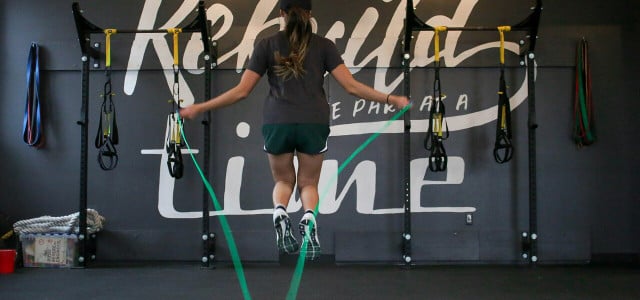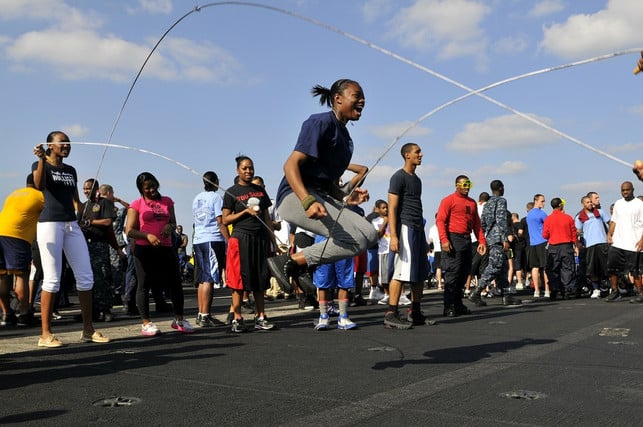
Do you only know jumping rope from the schoolyard when you were a child? Jumping rope is now a recognized sport that is very health-promoting. Here we show why this is the case and which exercises will help you.
Grabbing a rope and jumping like you did in childhood can be really fun. And not only that – jumping rope can be just as much a sport as, for example, jogging. Jumping rope can have similar positive effects on the body as other sports. Among other things, it can be used to burn calories in a playful way.
Jumping rope as a health factor

It is impossible to say in general how many calories you burn by jumping rope. A person weighing 70 kilograms consumes around 430 calories in 30 minutes. In contrast, jogging consumes around 330 calories, summarizes the sports magazine Runner’s World.
“Just a few minutes of rope jumping gets your circulation and metabolism going,” says Elisabeth Graser, lecturer at the German University for Prevention and Health Management (DHfPG).
But jumping rope also has many other positive effects for your health:
- Strengthens cardiovascular health
- Muscles in the legs and torso are trained
- The shock load has a positive effect on bone density
- The fascia also benefits from cushioning, which strengthens the connective tissue
- Improves endurance
- Stimulates fat burning
- Improves body awareness and balance
- Helps maintain mobility as you age
- Positive influence on mental health
- Reduces stress
- Improves the ability to concentrate through the attention required when swinging the rope in the right rhythm
- Jumping rope is one of the sports that burns a comparatively large amount of calories
The other advantages are obvious: you don’t need expensive fitness equipment and you don’t need a lot of space to practice. You can even easily take a skipping rope with you when traveling.
But be careful: If you have joint problems, excessive weight or cardiovascular weakness, you should avoid jumping rope as a sport or seek medical advice beforehand.
Rope selection and preparation
The first thing that is important is the selection of the rope: although there are special skipping ropes, a normal rope will usually do the trick. You can also make your own handles according to your own wishes. Simply take the rope in one hand and swing it along one side of your body. Does it swing well? Or is it somehow stuck? Is the air resistance too great? Next, check the length of the rope:
- To do this, stand with one foot on the rope.
- Pull the rope up on both sides so that it is taut.
- The ends must be level with your armpits. Then the rope is the right length.
- If the rope is a little too long, you don’t have to cut it. Instead, just wrap it around your hands.
Also make sure the surface is springy. Under no circumstances should you jump rope on hard ground such as asphalt. Otherwise you will put too much strain on your joints. We also recommend sports shoes that are also springy.
Before you start, you should warm up sufficiently. You can do this by circling your wrists, shoulders and arms, doing a few jumping jacks and lightly hopping or jogging in place.
Jump rope properly – this is what you should pay attention to

When you start, stand in this starting position:
- Your feet are together and parallel to each other.
- Your posture is straight and upright.
- Your elbows are close to your body.
- Your forearms and upper arms form approximately a right angle.
- The rope hangs loosely behind your feet.
When jumping rope, pay attention to the following:
- Don’t start too quickly. The rope should swing around you in a consistent rhythm. The rule of thumb is about one jump per second. Maybe music can help you.
- The movement comes from the wrists. Otherwise, your arms remain relatively still on your body.
- When jumping, you should make sure to only jump as high as necessary.
- Jump only on the ball of your foot, keeping your heel in the air.
- When you come back up, try to bounce your knees to cushion the jump. Under no circumstances should you jump with your knees locked. To check: the less noise you make, the better you will cushion yourself.
- The rope touches the ground lightly when jumping.
- Small hops can help you at the beginning, but you should break the habit in the long run.
- You can also jog through the rope at first.
- And: Don’t give up, every beginning is difficult! Your body probably needs to get used to the new rhythm. So start slowly, success will come with time.
Variations for rope sports
Are you already advanced and “normal” jumping rope is too boring for you? Then try these modifications:
- For example, you can jump on one leg: pull up one leg and hop ten times only on the other leg, then find a smooth transition and hop ten times only on the first leg. You can just as easily try to jump alternately on the left and right legs, i.e. once on the left, once on the right, once on the left and so on.
-
Change direction and jump backwards instead. This also trains your coordination skills.
- Advanced people can try cross-jumping: first jump with a normal rope, then cross your arms before the jump and jump like that. For the next jump, open your arms again, then cross them again and so on. However, finding the right moment to cross your arms requires a lot of practice in the beginning.
- Another variant is the double swing: During a jump, you swing the rope under your feet twice. But be prepared for a few bruises at first, because the double punch is not an easy trick.
- The variations in jumping rope are almost endless: you can alternate jumping forwards or backwards, to the sides, crossing and uncrossing your feet, anything you can think of. You can find further suggestions in numerous YouTube videos.
Your personal rope jumping training plan

How long and how often you jump rope depends entirely on you. The tips mentioned here are only intended to serve as a guide.
- Start with shorter intervals, don’t jump for fifteen minutes at a time at first. The strain caused by jumping rope can initially be unusual for joints, tendons and ligaments.
- It’s best to structure your rope jumping as interval training: Jump three to five times for one to three minutes each, taking a half-minute break in between.
- You can repeat the whole process several times. But after each round, take a slightly longer break of around two to three minutes.
- If you want quick training success, you should use the rope three to five times a week.
- Choose a slower pace at the beginning, about one jump per second. You can then increase this to up to 220 jumps per minute (which of course you don’t have to count).
- Alternatively, you can count jumps instead of minutes, so your training plan could be, for example: 100 times on both legs, 50 on the left, 50 on the right and so on.
Be patient with yourself if it doesn’t work straight away and your foot keeps getting caught in the rope, that’s completely normal. “It often takes several sessions before longer sequences can be achieved without getting caught in the rope,” says Elisabeth Graser. If the classic basic jump with both legs finally works, variations can be incorporated, as explained in the section above. Or you increase the pace to create a new training stimulus.
Despite all the training and all the endurance power, the most important thing is that you don’t forget to have fun. Because then jumping rope is a rewarding sport not only for your body, but also for your mind.
With material from dpa.
Edited by Nora Braatz
Read more on Techzle\.com:
- Make your own protein bars: vegan recipe for sporty people
- Power napping: More energy with the right nap
- 8 fitness equipment for at home: Sport can also be done without plastic
** marked with ** or orange underlined Links to sources of supply are partly partner links: If you buy here, you are actively supporting Techzle\.com, because we then receive a small part of the sales proceeds. More info.